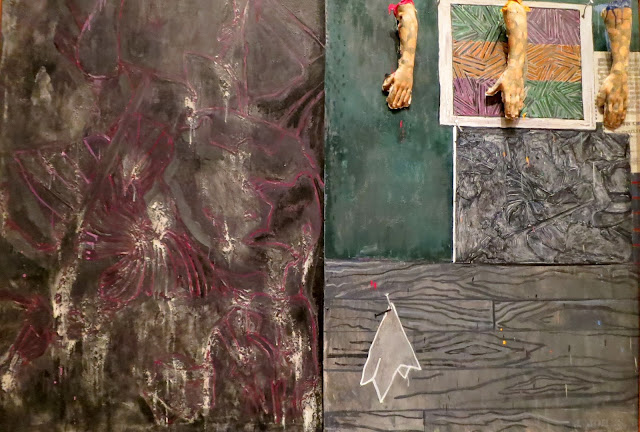'One hopes for something resembling truth, some sense of life, even of grace, to flicker, at least, in the work'. Jasper Johns, 2006
Jasper Johns at the Royal Academy, London.
Over more than six decades, Jasper Johns has pursued an intense investigation of the visual world and the human response to it. Through his work, he has sought to challenge the notion of 'truth', suggesting that it is not a given, but rather something that can exist beneath layered and shifting meanings. Routine ways of seeing, feeling and thinking render truth elusive, but when the senses are awakened, a flicker of grace occurs and new ways of experiencing the world allow us to glimpse it.
Flags, targets, numbers and letters:
Johns' flags, targets, numbers and letters established a new vocabulary in painting. His appropriation of objects and symbols - ingrained in consciousness since childhood - sought to make the familiar unfamiliar. One of the ways that he achieved this was through the complexity of the textures that he created on the painted surface. As well as making use of traditional materials and techniques, Johns continued to work regularly in the ancient, wax-based medium, encaustic. Often, he would combine this with collage, dipping paper or cloth into the wax to create subtle layered surfaces.
Target, 1961, (encaustic and collage on canvas)
Flag, 1967, (encaustic and collage on canvas, three panels)
Flag on Orange Field II, 1058, (encaustic on canvas)
Map, 1962-63, (encaustic and collage on canvas)
Target, 1992, (encaustic and collage on canvas)
Two Flags, 1959, (acrylic on canvas, two panels)
Numbers, 2007, (aluminium)
Figure 0, 1959, (encaustic and collage on paper)
...
Johns extended his ongoing examination of the relationship between sight and thought, and the shifting meanings inherent in even the most familiar things, to his sculptures of commonplace objects, which also question the nature of 'things which are seen and not looked at, not examined'.
The Critic Sees, 1961, (sculp-metal on plaster with glass)
Bread, 2012, (painted paper, lead, copper, wood and epoxy)
False Start, 1959
...
Many of Johns' paintings draw attention to their material components (stretcher, canvas, paint or frame) or their formal properties (colour, composition or scale). As well as presenting the painting as an object, Johns attached familiar things such as rulers, forks, coat hangers, wooden balls and hinged slats which alter the space and dimensions in which the works operate. In 1963, he explained that: 'My use of objects comes out of, originally, thinking of the painting as an object and considering the materialistic aspect of painting: seeing that painting was paint on canvas, and then by extension seeing that it occupied a space and sat on the wall'.
Field Painting, 1963-64
Decoy 1, 1971
Well, this is as far as I got, all these months ago, when we saw the exhibition. For some reason that I cannot quite fathom, I never got round to finishing this post, and I have the feeling that I never will.
So I decided to post it in its unfinished state.



















I'm glad that you got to see this fantastic exhibition.
ReplyDeleteIt was one of the highlights of the autumn, Olga.
Delete